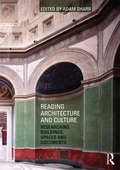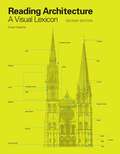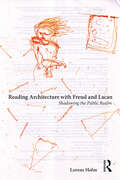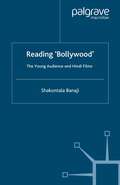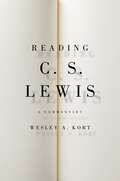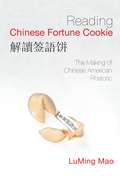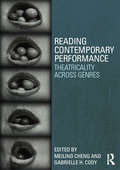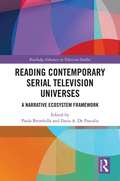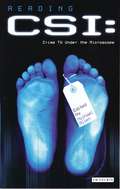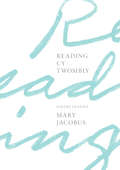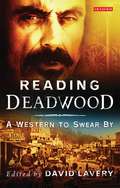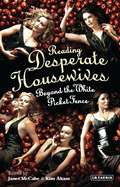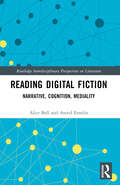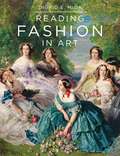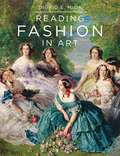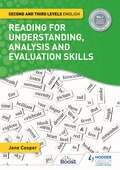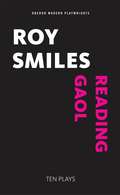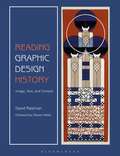- Table View
- List View
Reading Architecture and Culture: Researching Buildings, Spaces and Documents
by Adam SharrArchitecture displays the values involved in its inhabitation, construction, procurement and design. It traces the thinking of the individuals who have participated in it, their relationships, and their involvement in the cultures where they lived and worked. In this way, buildings, their details, and the documents used to make them, can be read closely for cultural insights. Introducing the idea of reading buildings as cultural artefacts, this book presents perceptive readings by eminent writers which demonstrate the power of this approach. The chapters show that close readings of architecture and its materials can test commonplace assumptions, help architects to appreciate the contexts in which they work, and indicate ways to think more astutely about design. The readings collected in this innovative and accessible book address buildings, specifications and photographs. They range in time from the fifteenth century – examining the only surviving drawing made by Leon Battista Alberti – to the recent past – projects completed by Norman Foster in 2006 and Herzog and De Meuron in 2008. They range geographically from France to Puerto Rico to Kazakhstan and they range in fame from buildings celebrated by critics to house extensions and motorway service areas. Taken together, these essays demonstrate important research methods which yield powerful insights for designers, critics and historians, and lessons for students.
Reading Architecture and Culture: Researching Buildings, Spaces and Documents
by Adam SharrArchitecture displays the values involved in its inhabitation, construction, procurement and design. It traces the thinking of the individuals who have participated in it, their relationships, and their involvement in the cultures where they lived and worked. In this way, buildings, their details, and the documents used to make them, can be read closely for cultural insights. Introducing the idea of reading buildings as cultural artefacts, this book presents perceptive readings by eminent writers which demonstrate the power of this approach. The chapters show that close readings of architecture and its materials can test commonplace assumptions, help architects to appreciate the contexts in which they work, and indicate ways to think more astutely about design. The readings collected in this innovative and accessible book address buildings, specifications and photographs. They range in time from the fifteenth century – examining the only surviving drawing made by Leon Battista Alberti – to the recent past – projects completed by Norman Foster in 2006 and Herzog and De Meuron in 2008. They range geographically from France to Puerto Rico to Kazakhstan and they range in fame from buildings celebrated by critics to house extensions and motorway service areas. Taken together, these essays demonstrate important research methods which yield powerful insights for designers, critics and historians, and lessons for students.
Reading Architecture Second Edition: A Visual Lexicon
by Owen HopkinsAnyone with an interest in buildings and the built environment would do well to purchase a copy of Owen Hopkins' book. - MonocleThis innovative and unique book is a visual guide to the buildings that surround us. Architectural features are pinpointed and labelled on images of buildings so that, unlike with other architectural dictionaries, you don't have to know the name before looking it up. Clear line drawings and extensive colour photographs illustrate each of the main building types, from forts to churches, stately homes to skyscrapers. The individual structural elements and materials common to all buildings are then explained, whether in Classical, Gothic or Modernist style. A comprehensive glossary completes the book. This revised edition includes an expanded section on modern structures and materials, as well as the latest styles and concepts from the last ten years. A must for all lovers of architecture and those who would like to learn moreOver 11,000 copies sold in English worldwide Covers all key building types and styles, from cathedrals to skyscrapers, Classical to contemporary. Each building type is illustrated with extensive photographs and annotated drawings Contains a comprehensive glossary of architectural terms
Reading Architecture with Freud and Lacan: Shadowing the Public Realm
by Lorens HolmReading Architecture with Freud and Lacan: Shadowing the Public Realm methodically outlines key concepts in psychoanalytic discourse by reading them against key modern and post-modern architects. It begins with what is, arguably, the central concept for each discipline by putting the unconscious in a dialectic relation to space. Each subsequent chapter begins with a detail in architectural discourse, a kind of provocation that anchors each excursion into the thought of Freud and Lacan. The text is cyclical, episodic, and cloudlike rather than expository; the intention is not simply to explain the concept of the unconscious but, to different degrees, perform it in the text. The book offers powerful critiques of current planning practice, which has no tools to address our attachment to places. It concludes with powerful critiques of our incapacity to change the environmentally damaging ways we live our lives, which is an effect of our incapacity to recognise the presence of the death drive in our nature. The text is an extended thesis – spanning the chapters – that the field of the Other is the common grammar that organises subjects into civilisations, which has consequences for how we treat the public realm in architecture, politics, and the city. The field of the Other is a slightly different slice through the urban social world. It shadows – but does not correspond exactly to – more familiar categories like private/public, inside/outside, figure/ground, or piazza/boulevard. Reading Architecture with Freud and Lacan will be an essential resource to anyone interested in how the environment we build is a reflection of our desire. Psychoanalysis is one of the great humanist discourses of the 20th century and this book will be a valuable reference to the humanist in architects, planners, and social scientists, whether they are students, professionals, or amateurs. It will appeal to historians of the 20th century, and to psychoanalysts and architects who are interested in how their respective discourses interdigitate with each other and with other discourses.
Reading Architecture with Freud and Lacan: Shadowing the Public Realm
by Lorens HolmReading Architecture with Freud and Lacan: Shadowing the Public Realm methodically outlines key concepts in psychoanalytic discourse by reading them against key modern and post-modern architects. It begins with what is, arguably, the central concept for each discipline by putting the unconscious in a dialectic relation to space. Each subsequent chapter begins with a detail in architectural discourse, a kind of provocation that anchors each excursion into the thought of Freud and Lacan. The text is cyclical, episodic, and cloudlike rather than expository; the intention is not simply to explain the concept of the unconscious but, to different degrees, perform it in the text. The book offers powerful critiques of current planning practice, which has no tools to address our attachment to places. It concludes with powerful critiques of our incapacity to change the environmentally damaging ways we live our lives, which is an effect of our incapacity to recognise the presence of the death drive in our nature. The text is an extended thesis – spanning the chapters – that the field of the Other is the common grammar that organises subjects into civilisations, which has consequences for how we treat the public realm in architecture, politics, and the city. The field of the Other is a slightly different slice through the urban social world. It shadows – but does not correspond exactly to – more familiar categories like private/public, inside/outside, figure/ground, or piazza/boulevard. Reading Architecture with Freud and Lacan will be an essential resource to anyone interested in how the environment we build is a reflection of our desire. Psychoanalysis is one of the great humanist discourses of the 20th century and this book will be a valuable reference to the humanist in architects, planners, and social scientists, whether they are students, professionals, or amateurs. It will appeal to historians of the 20th century, and to psychoanalysts and architects who are interested in how their respective discourses interdigitate with each other and with other discourses.
Reading 'Bollywood': The Young Audience and Hindi Films
by S. BanajiThis book explores representations of gender, sexuality and ethnicity in Hindi films, in the socio-political context and in terms of how young audiences in India and the UK construct them. In-depth interviews, observations and photographs provide insights into spectatorship and comparison with theories about Hindi film and popular culture.
Reading C.S. Lewis: A Commentary
by Wesley A. KortFrom the unbending belief in invisible powers that animates Till We Have Faces to the depiction of Aslan's sacrifice and resurrection in The Lion, The Witch, and the Wardrobe, C. S. Lewis's writing has sparked intense debate about the presence and function of religion in his works. Today, a reader's opinion of Lewis is more often than not based on his or her perspectives on religion. In Reading C. S. Lewis, Wesley A. Kort examines Lewis's work as a whole, investigating why and at what points Lewis turns to religion-and particularly to Christianity-in order to advance his arguments. Kort moves through more than a dozen of Lewis's major books, providing a useful guide to their various elements while connecting readers to the literary contexts that influenced the works and Lewis himself. Reading C. S. Lewis examines the standing of Lewis's work, how best to approach the books, and the misunderstandings that lead to mistaken readings. The commentaries also function as free-standing essays that can be read individually and in any order. Reading C. S. Lewis: A Commentary sets a new standard for C. S. Lewis studies. A comprehensive examination of the major Lewis texts, this volume is a captivating look into the author's work from a refreshingly undogmatic point of view.
Reading C.S. Lewis: A Commentary
by Wesley A. KortFrom the unbending belief in invisible powers that animates Till We Have Faces to the depiction of Aslan's sacrifice and resurrection in The Lion, The Witch, and the Wardrobe, C. S. Lewis's writing has sparked intense debate about the presence and function of religion in his works. Today, a reader's opinion of Lewis is more often than not based on his or her perspectives on religion. In Reading C. S. Lewis, Wesley A. Kort examines Lewis's work as a whole, investigating why and at what points Lewis turns to religion-and particularly to Christianity-in order to advance his arguments. Kort moves through more than a dozen of Lewis's major books, providing a useful guide to their various elements while connecting readers to the literary contexts that influenced the works and Lewis himself. Reading C. S. Lewis examines the standing of Lewis's work, how best to approach the books, and the misunderstandings that lead to mistaken readings. The commentaries also function as free-standing essays that can be read individually and in any order. Reading C. S. Lewis: A Commentary sets a new standard for C. S. Lewis studies. A comprehensive examination of the major Lewis texts, this volume is a captivating look into the author's work from a refreshingly undogmatic point of view.
Reading Chinese Fortune Cookie: The Making of Chinese American Rhetoric
by LuMing MaoLuMing Mao offers an important discussion of the rhetoric of Chinese American speakers, which has wide implications for the teaching of writing in English and for our understanding of cross-cultural influences in discourse. Recent scholarship tends to explain such influences as contributing to language hybridity---an advance over the traditional "deficit model." But Mao suggests that the "hybridity" approach is perhaps too arid or sanitized, missing rich nuances of mutual exchange, resistance, or even subversion. Working from Ang's concept of "togetherness in difference," Mao suggests that speakers of hybrid discourse may not be attempting the standard (and failing), but instead may be deliberately importing cultural material to create a distance between themselves and the standard. This practice, over time, becomes a process that transforms English, enriching and enlarging it through the infusion of non-Western discourse features, subverting power structures, and even providing unique humorous touches. Of interest to scholars in composition, cultural studies, and linguistics as well, Reading Chinese Fortune Cookie leads in an important new direction for both our understanding and our teaching of English.
Reading Contemporary Performance: Theatricality Across Genres
by Meiling Cheng Gabrielle H. CodyAs the nature of contemporary performance continues to expand into new forms, genres and media, it requires an increasingly diverse vocabulary. Reading Contemporary Performance provides students, critics and creators with a rich understanding of the key terms and ideas that are central to any discussion of this evolving theatricality. Specially commissioned entries from a wealth of contributors map out the many and varied ways of discussing performance in all of its forms – from theatrical and site-specific performances to live and New Media art. The book is divided into two sections: Concepts - Key terms and ideas arranged according to the five characteristic elements of performance art: time; space; action; performer; audience. Methodologies and Turning Points - The seminal theories and ways of reading performance, such as postmodernism, epic theatre, feminisms, happenings and animal studies. Case Studies – entries in both sections are accompanied by short studies of specific performances and events, demonstrating creative examples of the ideas and issues in question. Three different introductory essays provide multiple entry points into the discussion of contemporary performance, and cross-references for each entry also allow the plotting of one’s own pathway. Reading Contemporary Performance is an invaluable guide, providing not just a solid set of familiarities, but an exploration and contextualisation of this broad and vital field.
Reading Contemporary Performance: Theatricality Across Genres
by Gabrielle Cody Meiling ChengAs the nature of contemporary performance continues to expand into new forms, genres and media, it requires an increasingly diverse vocabulary. Reading Contemporary Performance provides students, critics and creators with a rich understanding of the key terms and ideas that are central to any discussion of this evolving theatricality. Specially commissioned entries from a wealth of contributors map out the many and varied ways of discussing performance in all of its forms – from theatrical and site-specific performances to live and New Media art. The book is divided into two sections: Concepts - Key terms and ideas arranged according to the five characteristic elements of performance art: time; space; action; performer; audience. Methodologies and Turning Points - The seminal theories and ways of reading performance, such as postmodernism, epic theatre, feminisms, happenings and animal studies. Case Studies – entries in both sections are accompanied by short studies of specific performances and events, demonstrating creative examples of the ideas and issues in question. Three different introductory essays provide multiple entry points into the discussion of contemporary performance, and cross-references for each entry also allow the plotting of one’s own pathway. Reading Contemporary Performance is an invaluable guide, providing not just a solid set of familiarities, but an exploration and contextualisation of this broad and vital field.
Reading Contemporary Serial Television Universes: A Narrative Ecosystem Framework (Routledge Advances in Television Studies)
by Paola Brembilla Ilaria A. De PascalisReading Contemporary Serial Television Universes provides a new framework—the metaphor of the narrative ecosystem—for the analysis of serial television narratives. Contributors use this metaphor to address the ever-expanding and evolving structure of narratives far beyond their usual spatial and temporal borders, in general and in reference to specific series. Other scholarly approaches consider each narrative as composed of modular elements, which combine to create a bigger picture. The narrative ecosystem approach, on the other hand, argues that each portion of the narrative world contains all of the main elements that characterize the world as a whole, such as narrative tensions, production structures, creative dynamics and functions. The volume details the implications of the narrative ecosystem for narrative theory and the study of seriality, audiences and fandoms, production, and the analysis of the products themselves.
Reading Contemporary Serial Television Universes: A Narrative Ecosystem Framework (Routledge Advances in Television Studies)
by Paola Brembilla Ilaria A. De PascalisReading Contemporary Serial Television Universes provides a new framework—the metaphor of the narrative ecosystem—for the analysis of serial television narratives. Contributors use this metaphor to address the ever-expanding and evolving structure of narratives far beyond their usual spatial and temporal borders, in general and in reference to specific series. Other scholarly approaches consider each narrative as composed of modular elements, which combine to create a bigger picture. The narrative ecosystem approach, on the other hand, argues that each portion of the narrative world contains all of the main elements that characterize the world as a whole, such as narrative tensions, production structures, creative dynamics and functions. The volume details the implications of the narrative ecosystem for narrative theory and the study of seriality, audiences and fandoms, production, and the analysis of the products themselves.
Reading 'CSI': Crime TV Under the Microscope (Reading Contemporary Television)
by Michael AllenThis is what we know, this is the truth: CSI is a global television phenomenon. It began in 2000 with 'CSI: Crime Scene Investigation', a dark procedural drama about forensic science set within the neon escapism of Las Vegas, in which Grissom and his team search within the very vitals of the murder victims they investigate. Nearly 17 million viewers tuned in each week and 'CSI: Crime Scene Investigation' fast became America's number one show. The success of the series moved it into franchise territory, continuing in 2002 with the body beautifuls and dismembereds of 'CSI: Miami' (now the world's biggest television show) and again in 2004 extending the francise to the melancholic noir of post-9/11 New York with 'CSI: NY'.Reading 'CSI' pieces together the evidence in order to understand what the CSI shows mean to contemporary television culture, both in America and beyond. The varied, intellectually curious and often polemic responses to CSI from critics, journalists and industry professionals focus on a range of issues from the pornographic quality of the CGI effects, the relationship of characters to their narratives, and the reaction of the fans, to the semiotics of Horatio Caine's sunglasses. This in depth, compulsive read also includes a full episode guide.
Reading Cy Twombly: Poetry in Paint
by Mary JacobusMany of Cy Twombly's paintings and drawings include handwritten words and phrases—naming or quoting poets ranging from Sappho, Homer, and Virgil to Mallarmé, Rilke, and Cavafy. Enigmatic and sometimes hard to decipher, these inscriptions are a distinctive feature of his work. Reading Cy Twombly poses both literary and art historical questions. How does poetic reference in largely abstract works affect their interpretation?Reading Cy Twombly is the first book to focus specifically on the artist’s use of poetry. Twombly’s library formed an extension of his studio and he sometimes painted with a book open in front of him. Drawing on original research in an archive that includes his paint-stained and annotated books, Mary Jacobus’s account—richly illustrated with more than 125 color and black-and-white images—unlocks an important aspect of Twombly’s practice.Jacobus shows that poetry was an indispensable source of reference throughout Twombly’s career; as he said, he "never really separated painting and literature." Among much else, she explores the influence of Ezra Pound and Charles Olson; Twombly’s fondness for Greek pastoral poetry and Virgil’s Eclogues; the inspiration of the Iliad and Ovid’s Metamorphoses; and Twombly’s love of Keats and his collaboration with Octavio Paz.Twombly’s art reveals both his distinctive relationship to poetry and his use of quotation to solve formal problems. A modern painter, he belongs in a critical tradition that goes back, by way of Roland Barthes, to Baudelaire. Reading Cy Twombly opens up fascinating new readings of some of the most important paintings and drawings of the twentieth century.
Reading Cy Twombly: Poetry in Paint
by Mary JacobusMany of Cy Twombly's paintings and drawings include handwritten words and phrases—naming or quoting poets ranging from Sappho, Homer, and Virgil to Mallarmé, Rilke, and Cavafy. Enigmatic and sometimes hard to decipher, these inscriptions are a distinctive feature of his work. Reading Cy Twombly poses both literary and art historical questions. How does poetic reference in largely abstract works affect their interpretation?Reading Cy Twombly is the first book to focus specifically on the artist’s use of poetry. Twombly’s library formed an extension of his studio and he sometimes painted with a book open in front of him. Drawing on original research in an archive that includes his paint-stained and annotated books, Mary Jacobus’s account—richly illustrated with more than 125 color and black-and-white images—unlocks an important aspect of Twombly’s practice.Jacobus shows that poetry was an indispensable source of reference throughout Twombly’s career; as he said, he "never really separated painting and literature." Among much else, she explores the influence of Ezra Pound and Charles Olson; Twombly’s fondness for Greek pastoral poetry and Virgil’s Eclogues; the inspiration of the Iliad and Ovid’s Metamorphoses; and Twombly’s love of Keats and his collaboration with Octavio Paz.Twombly’s art reveals both his distinctive relationship to poetry and his use of quotation to solve formal problems. A modern painter, he belongs in a critical tradition that goes back, by way of Roland Barthes, to Baudelaire. Reading Cy Twombly opens up fascinating new readings of some of the most important paintings and drawings of the twentieth century.
Reading Deadwood: A Western to Swear By (Reading Contemporary Television)
by David LaveryApart from its brilliance as television, it's amazing what Deadwood gets away with. This acclaimed series from HBO, which premiered in 2004, is set in the teeming outlaw camp of Deadwood. It has been described by Variety as 'a vulgar, gritty, at times downright nasty take on the Old West brimming with all the dark genius that series creator and screenwriter extraordinaire David Milch has at his fingertips'. All this and more. The international cast of authoritative contributors assess Deadwood's many facets: its profane language, its characters, from Al Swearengen (who lives up to his name) and Calamity Jane, to E.B. Farnham and Mr Wu, its place in the western genre, Deadwood and serial fiction, prostitution, the making of American civil society, Deadwood's Chinese, the opening credits, Reverend Smith and much more. Episode and character guides complete the book - the Deadwood companion for fans and studentsto swear by.
Reading 'Desperate Housewives': Beyond the White Picket Fence (Reading Contemporary Television)
by Janet McCabe Kim Akass'Everyone has a little dirty laundry.' The darkly comic series about the secret lives of the ladies living on Wisteria Lane became an instant breakthrough hit for ABC. 21 million viewers tuned in for the first episode and this figure has steadily grown as audiences from around the globe have switched on to the shenanigans in suburbia. Desperate Housewives was subject to a backlash in America, where advertisers on the ABC network were lobbied by Christian groups and Parents' Associations. But the sponsorship withdrawal that resulted did little to dampen the enthusiasm of its legions of fans. Recipient of several awards including the People's Choice Award and Golden Globe for Best Television – Musical or Comedy, Desperate Housewives is a hit. Reading Desperate Housewives offers a critical response to one of the most talked about shows on contemporary television. Leading scholars and writers dissect the appeal of Desperate Housewives, tapping into early reactions and controversy. They consider the American sex wars, contemporary feminism, Republican politics and the rise of the Right, gender and femininity, motherhood and marriage – and that Vanity Fair shoot. The book includes an episode guide tracing all those goings-on beyond that white picket fence.
Reading Digital Fiction: Narrative, Cognition, Mediality (Routledge Interdisciplinary Perspectives on Literature)
by Alice Bell Astrid EnsslinReading Digital Fiction offers the first comprehensive and systematic theoretical, methodological, and analytical examination of digital fiction from a cognitive and empirical perspective. Proposing the new concept of “medial reading”, it argues for the centrality of an audience’s interest in, awareness of and/or attention to the medium in which a text is produced and received, and which we argue should be applied to reader data across media. The book analyses and theorises five generations of digital fiction and their reading including hypertext fiction, hypermedia fiction, narrative video games, app fiction, and virtual reality. It showcases medium- and platform-specific methods of qualitative reader response research across a variety of contexts and settings from screen-based and embodied interaction to gallery installation, and from reading group and individual interview to think-aloud methodologies. The book thus addresses the unique affordances of digital fiction reading by designing and reporting on new empirical studies focusing on hypertextuality, interactivity, immersion, as well as medium-specific forms of textual “you”, ontological ambiguity, reader orientation and empathy. In so doing, the book refines, critiques, and expands cognitive, transmedial, and empirical narratology and stylistics by placing the reader of these new narratives front and centre.
Reading Digital Fiction: Narrative, Cognition, Mediality (Routledge Interdisciplinary Perspectives on Literature)
by Alice Bell Astrid EnsslinReading Digital Fiction offers the first comprehensive and systematic theoretical, methodological, and analytical examination of digital fiction from a cognitive and empirical perspective. Proposing the new concept of “medial reading”, it argues for the centrality of an audience’s interest in, awareness of and/or attention to the medium in which a text is produced and received, and which we argue should be applied to reader data across media. The book analyses and theorises five generations of digital fiction and their reading including hypertext fiction, hypermedia fiction, narrative video games, app fiction, and virtual reality. It showcases medium- and platform-specific methods of qualitative reader response research across a variety of contexts and settings from screen-based and embodied interaction to gallery installation, and from reading group and individual interview to think-aloud methodologies. The book thus addresses the unique affordances of digital fiction reading by designing and reporting on new empirical studies focusing on hypertextuality, interactivity, immersion, as well as medium-specific forms of textual “you”, ontological ambiguity, reader orientation and empathy. In so doing, the book refines, critiques, and expands cognitive, transmedial, and empirical narratology and stylistics by placing the reader of these new narratives front and centre.
Reading Fashion in Art
by Ingrid E. MidaDress and fashion are central to our understanding of art. From the stylization of the body to subtle textile embellishments and richly symbolic colors, dress tells a story and provides clues as to the cultural beliefs of the time in which artworks were produced. This concise and accessible book provides a step-by-step guide to analysing dress in art, including paintings, photographs, drawings and art installations. The first section of the book includes an introduction to visual analysis and explains how to 'read' fashion and dress in an artwork using the checklists. The second section offers case studies which demonstrate how artworks can be analysed from the point of view of key themes including status and identity, modernity, ideals of beauty, gender, race, globalization and politics. The book includes iconic as well as lesser known works of art, including work by Elisabeth Vigée le Brun, Thomas Gainsborough, James Jacques Tissot, Marcel Duchamp and Man Ray, Yinka Shonibare, Mickalene Thomas, Kent Monkman and many others. Reading Fashion in Art is the perfect text for students of fashion coming to art history for the first time as well as art history students studying dress in art and will be an essential handbook for any gallery visitor. The step-by-step methodology helps the reader learn to look at any work of art that includes the dressed or undressed body and confidently develop a critical analysis of what they see.
Reading Fashion in Art
by Ingrid E. MidaDress and fashion are central to our understanding of art. From the stylization of the body to subtle textile embellishments and richly symbolic colors, dress tells a story and provides clues as to the cultural beliefs of the time in which artworks were produced. This concise and accessible book provides a step-by-step guide to analysing dress in art, including paintings, photographs, drawings and art installations. The first section of the book includes an introduction to visual analysis and explains how to 'read' fashion and dress in an artwork using the checklists. The second section offers case studies which demonstrate how artworks can be analysed from the point of view of key themes including status and identity, modernity, ideals of beauty, gender, race, globalization and politics. The book includes iconic as well as lesser known works of art, including work by Elisabeth Vigée le Brun, Thomas Gainsborough, James Jacques Tissot, Marcel Duchamp and Man Ray, Yinka Shonibare, Mickalene Thomas, Kent Monkman and many others. Reading Fashion in Art is the perfect text for students of fashion coming to art history for the first time as well as art history students studying dress in art and will be an essential handbook for any gallery visitor. The step-by-step methodology helps the reader learn to look at any work of art that includes the dressed or undressed body and confidently develop a critical analysis of what they see.
Reading for Understanding, Analysis and Evaluation Skills: Second and Third Levels English
by Jane CooperSyllabus: CfE (Curriculum for Excellence, from Education Scotland) and SQALevel: BGE S1-3: Third & Fourth LevelsSubject: EnglishCapture pupils' imagination and attention with a rich collection of quality texts, handpicked by Jane Cooper to ensure that pupils want to start reading - and keep reading.Tailored to the interests, motivations and abilities of pupils working towards Second and Third Levels in S1 to S3, this book will help you to close the attainment gap.> Unlock a world of meaning, connection and questioning. Part One teaches the close reading skills that pupils need throughout their lives, with simple explanations, lots of examples and tasks set at three levels - 'Building', 'Strengthening' and 'Extending'.> Apply and develop RUAE skills and monitor progress. Part Two contains ten practice assessments that gradually increase in difficulty, with longer passages, more complex language and more challenging questions.> Save time sourcing non-fiction text extracts. Drawing on her long career as an English teacher and author, Jane Cooper has a talent for knowing which topics pupils will find curious or fun - from the world's cheesiest pizza to a mysterious metal column that appeared in a desert.> Build the foundations for success in National qualifications. With Course Reports showing that N5 and Higher students most commonly lose marks in the RUAE papers, this book offers a proactive solution to building confidence and skills during BGE.> Support the individual needs of every pupil. Providing differentiated, age-appropriate content and tasks, this is the perfect resource for mixed-ability classrooms - especially when used alongside its companion volume, Levels 3-4 English: Reading for Understanding, Analysis and Evaluation Skills.
Reading Gaol (Oberon Modern Playwrights)
by Roy SmilesReading Gaol concerns Oscar Wilde’s imprisonment in Reading Gaol after his infamous court case, persecuted relentlessly by the sadistic and pious prison governor for refusing to admit he is a common criminal. George Bernard Shaw, Frank Harris, Sid Edward Carson and Lord Alfred Douglas appear as Wilde justifies his self-inflicted martyrdom.‘Football is all very well as a game for rough girls, but is hardly suitable for delicate boys’ - Oscar Wilde.
Reading Graphic Design History: Image, Text, and Context
by David RaizmanReading Graphic Design History uses a series of key artifacts from the history of print culture in light of their specific historical contexts. It encourages the reader to look carefully and critically at print advertising, illustration, posters, magazine art direction and typography, often addressing issues of class, race and gender.David Raizman's innovative approach intentionally challenges the canon of graphic design history and various traditional understandings of graphic design. He re-examines 'icons' of graphic design in light of their local contexts, avoiding generalisation to explore underlying attitudes about various social issues. He encourages new ways of reading graphic design that take into account a broader context for graphic design activity, rather than broad views that discourage the understanding of difference and the means by which graphic design communicates cultural values.
